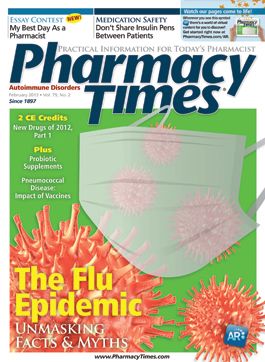
Publication
Article
Pharmacy Times
Don't Share Insulin Pens Between Patients
Author(s):
Sterility is not maintained by putting a new needle on a used pen device.

Sterility is not maintained by putting a new needle on a used pen device.
A single insulin pen device is never suitable for use with multiple patients due to the risk of cross contamination and transmission of bloodborne diseases. Air bubbles and pathogenic contaminants can enter the cartridge after injection while the needle is still attached to the pen.1
In 2009, the Institute for Safe Medication Practices (ISMP) cooperated with the FDA on a Patient Safety News video (http://phrmcyt.ms/VFIsbF) that discusses how contamination can happen. The video was prompted by a 2009 incident at 2 US Army hospitals in which 2114 insulin-dependent patients with diabetes were placed at risk because insulin pens were used for multiple patients.
An Illusion of Safety
Repeated event reports suggest that there is an alarming and widespread misunderstanding that sterility can be maintained between patients by affixing a fresh needle on a pen device. An incident in 2010 in Wisconsin required notification of more than 2000 potentially exposed patients due to inappropriate sharing of insulin demonstration pens used during patient training. Two reports submitted to the ISMP National Medication Errors Reporting Program describe nurses knowingly using the same insulin pen for multiple patients. Both nurses thought the practice was acceptable because they changed the needle between patients. In one case, it was later determined that the original patient had HIV. Followup exposure treatment and testing were being conducted on the affected patient.
According to the Centers for Disease Control and Prevention (CDC), evidence continues to mount that this dangerous practice is still affecting thousands of patients (http://phrmcyt.ms/XymQwa). This concern led the CDC to issue a clinical reminder (http://phrmcyt.ms/ RSCFhK), stating that the agency has increasingly become aware of reports of improper use of insulin pens, which places individuals at risk of infection.
Safeguarding Patients
Health care practitioners must be aware and educate patients that insulin pens are meant for use on a single person only, and should never be shared with others, even when the needle is changed. Likewise, pen needles and fingerstick devices should not be reused on the same patient or shared with others. This should be explained to all patients by prescribers and pharmacists when patients receive a prescription for or are dispensed an insulin pen.
In acute care, long-term care, and group home/residential settings, insulin pens should be assigned to individual patients and labeled accordingly. Space is lacking on the pen for application of a patient label, so pharmacists must affix a “flag” label, taking care to attach the label to the body of the pen, not the cap, without covering the drug name. If the label is on the cap, once the cap is removed, the pen is no longer labeled for a specific person.
Timely staff education and ongoing monitoring is critical to assuring safe use of insulin pens. Long-term care facilities may find education and monitoring difficult to accomplish due to staff turnover and time constraints, but this should not hinder them from collaborating with their pharmacy providers to determine how often educational programs must be conducted and to consider other safeguards to put in place.
Insulin demonstration pens, which typically contain saline solution, are used to teach patients dosing and administration technique. However, they are NOT intended to be used on patients. Patients should practice administering the dose by injecting the saline solution into an orange.
Please keep in mind that other medications (eg, exenatide, teriparatide)—not just insulin—are available in pen injectors. These devices carry similar risks of cross contamination and transmission of blood-borne diseases when shared among patients. The safe practice recommendations above should be applied to all pen injector devices.
Dr. Gaunt is a medication safety analyst and the editor of ISMP Medication Safety Alert! Community/Ambulatory Care Edition.
References:
- Sonoki K, Yoshinari M, Iwase M, et al. Regurgitation of blood into insulin cartridges in the pen-like injectors. Diabetes Care. 2001;24(3):603-604. http://care.diabetesjournals.org/cgi/content/full/24/3/603.

2 Commerce Drive
Cranbury, NJ 08512
All rights reserved.





